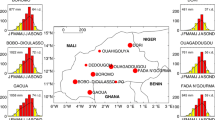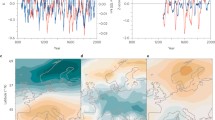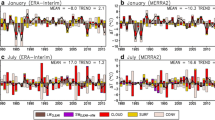Abstract
The evolution of mean annual minimum (TMIN) and maximum temperature (TMAX) on the Swiss Plateau shows distinct differences over the last 150 years. TMIN increased relatively steadily by about 3 °C. TMAX increased by only 1.5 °C with substantial decadal variability and hardly any increase until about 1940. However, in the most recent decades, TMAX trends are somewhat larger than TMIN trends. While most aspects of the TMIN evolution can be well explained by the global forcing and the modifying effects of the large-scale atmospheric flow alone, local sunshine duration (SD) information is crucial to explain major features of the TMAX series and the differences between TMIN and TMAX since about 1950. SD shows no clear trend until 1950, a decline from 1950 to 1980 and an increase since 1980 resembling the global dimming and brightening signal. TMAX is strongly influenced by SD and the TMAX evolution can be well reconstructed with local TMIN and SD. Strong TMAX declines are found from 1950 to the 1970s. TMIN shows no trend in this period. Between 1980 and about 2005, both TMIN and TMAX show strong increases caused by the greenhouse gas forcing, decreasing aerosols and probably also decreasing cloud cover. Since about 2005, the increases are weaker. The brightening has weakened and the warming effect of the continuously growing greenhouse gas forcing has additionally been reduced by cooling effects caused by large-scale atmospheric flow anomalies. The reasons for the considerable differences in the TMIN and TMAX evolution prior to 1950 remain unknown and further investigations are needed to shed more light on this disparity.



Similar content being viewed by others
References
Bader S, Fukutome S (2015) Milde und kalte Bergwinter. Fachbericht MeteoSchweiz 254, 10 pp (in German)
Barnston AG, Livezey RE (1987) Classification, seasonality and persistence of low-frequency atmospheric circulation patterns. Mon Weather Rev 115:1083–1126. https://doi.org/10.1175/1520-0493(1987)115<1083:CSAPOL>2.0.CO;2
Baumgartner DJ, Pötzi W, Freislich H, Strutzmann H, Veronig AM, Foelsche U, Rieder HE (2018) A comparison of long-term parallel measurements of sunshine duration obtained with a Campbell-Stokes sunshine recorder and two automated sunshine sensors. Theor Appl Climatol 133:263–275. https://doi.org/10.1007/s00704-017-2159-9
Begert M, Frei C (2018) Long-term area-mean temperature series for Switzerland – combining homogenized station data and high resolution grid data. Int J Climatol 38:2792–2807. https://doi.org/10.1002/joc.5460
Begert M, Schlegel T, Kirchhofer W (2005) Homogeneous temperature and precipitation series of Switzerland from 1864 to 2000. Int J Climatol 25:65–80. https://doi.org/10.1002/joc.1118
Burton B (2014) Stevenson screen temperatures – an investigation. Weather 69:156–160. https://doi.org/10.1002/wea.2166
Compo GP, Whitaker JS, Sardeshmukh PD, Matsui N, Allan RJ, Yin X, Gleason BE, Vose RS, Rutledge G, Bessemoulin P, Brönnimann S, Brunet M, Crouthamel RI, Grant AN, Groisman PY, Jones PD, Kruk M, Kruger AC, Marshall GJ, Maugeri M, Mok HY, Nordli Ø, Ross TF, Trigo RM, Wang XL, Woodruff SD, Worley SJ (2011) The twentieth century reanalysis project. Q J R Meteorol Soc 137:1–28. https://doi.org/10.1002/qj.776
Dai A, Del Genio AD, Fung IY (1997) Clouds, precipitation and temperature range. Science 386:665–666. https://doi.org/10.1038/386665b0
Dai A, Trenberth KE, Karl TR (1999) Effects of clouds, soil moisture, precipitation, and water vapor on diurnal temperature range. J Clim 12:2451–2473. https://doi.org/10.1175/1520-0442(1999)012<2451:EOCSMP>2.0.CO;2
Davy R, Esau I, Chernokulsky A, Outten S, Zilitinkevich S (2017) Diurnal asymmetry to the observed global warming. Int J Climatol 37:79–93. https://doi.org/10.1002/joc.4688
Draper N, Smith H (1981) Applied regression analysis, 2nd edn. John Wiley & Sons, Inc., New York
Easterling DR et al (1997) Maximum and minimum temperature trends for the globe. Science 277:364–367. https://doi.org/10.1126/science.277.5324.364
Esau I, Davy R, Outten S (2012) Complementary explanation of temperature response in the lower atmosphere. Environ Res Lett 7. https://doi.org/10.1088/1748-9326/7/4/044026
IPCC (2013) Summary for policymakers. In: Stocker TF, Qin D, Plattner G-K, Tignor M, Allen SK, Boschung J, Nauels A, Xia Y, Bex V and Midgley PM (eds) Climate change 2013: the physical science basis. Contribution of working group I to the fifth assessment report of the intergovernmental panel on climate change. Cambridge University Press, Cambridge and New York
Jones PD, New M, Parker DE, Martin S, Rigor IG (1999) Surface air temperature and its changes over the past 150 years. Rev Geophys 37(2):173–199. https://doi.org/10.1029/1999RG900002
Karl TR, Jones PD, Knight RW, Kukla G, Plummer N, Razuvayev V, Gallo KP, Lindseay J, Charlson RJ, Peterson TC (1993) A new perspective on recent global warming: asymmetric trends of daily maximum and minimum temperature. Bull Am Meteorol Soc 74:1007–1023
McNider RT, Steeneveld GJ, Holtslag AAM, Pielke RA Sr, Mackaro S, Pour-Biazar A, Walters J, Nair U, Christy J (2012) Response and sensitivity of the nocturnal boundary layer over land to added longwave radiative forcing. J Geophys Res 117:D14106. https://doi.org/10.1029/2012JD017578
MeteoSchweiz (2018) Klimareport 2017. Bundesamt für Meteorologie und Klimatologie MeteoSchweiz, Zürich. ISSN 2296–1488, 84 pp (in German, also available in French and Italian)
Morice CP, Kennedy JJ, Rayner NA, Jones PD (2012) Quantifying uncertainties in global and regional temperature change using an ensemble of observational estimates: the HadCRUT4 data set. J Geophys Res 117:D08101. https://doi.org/10.1029/2011JD017187
Nordli PØ, Alexandersson H, Frich P, Førland EJ, Heino R, Jónsson T, Tuomenvirta H, Tveito OE (1997) The effect of radiation screens on Nordic time series of mean temperature. Int J Climatol 17:1667–1681. https://doi.org/10.1002/(SICI)1097-0088(199712)17:15%3C1667::AID-JOC221%3E3.0.CO;2-D
Philipona R, Behrens K, Ruckstuhl C (2009) How declining aerosols and rising greenhouse gases forced rapid warming in Europe since the 1980s. Geophys Res Lett 36:L02806. https://doi.org/10.1029/2008GL036350
R Core Team (2016) R: a language and environment for statistical computing. R Foundation for statistical computing, Vienna, Austria. URL https://www.R-project.org/
Ruckstuhl C, Philipona R, Behrens K, Collaud Coen M, Dürr B, Heimo A, Mätzler C, Nyeki S, Ohmura A, Vuilleumier L, Weller M, Wehrli C, Zelenka A (2008) Aerosol and cloud effects on solar brightening and the recent rapid warming. Geophys Res Lett 35:L12708. https://doi.org/10.1029/2008GL034228
Saffioti C, Fischer EM, Scherrer SC, Knutti R (2016) Reconciling observed and modeled temperature and precipitation trends over Europe by adjusting for circulation variability. Geophys Res Lett 43:8189–8198. https://doi.org/10.1002/2016GL069802
Sanchez-Lorenzo A, Wild M (2012) Decadal variations in estimated surface solar radiation over Switzerland since the late 19th century. Atmos Chem Phys Discuss 12:10,815–10,843. https://doi.org/10.5194/acpd-12-10815-2012
Schär C, Vidale PL, Lüthi D, Frei C, Häberli C, Liniger MA, Appenzeller C (2004) The role of increasing temperature variability in European summer heatwaves. Nature 427:332–336. https://doi.org/10.1038/nature02300
Scherrer SC (2006) Interannual climate variability in the European and Alpine region, Dissertation Nr. 16338, ETH Zürich, 120 pp. https://doi.org/10.3929/ethz-a-005133273
Sen PK (1968) Estimates of the regression coefficient based on Kendall’s tau. J Am Stat Assoc 63:1379–1389. https://doi.org/10.2307/2285891
Seneviratne SI, Lüthi D, Litschi M, Schär C (2006) Land-atmosphere coupling and climate change in Europe. Nature 443:205–209. https://doi.org/10.1038/nature05095
Sun B, Groisman PY, Bradley R, Keimig F (2000) Temporal changes in the observed relationship between cloud cover and surface air temperature. J Clim 13(12):4341–4357. https://doi.org/10.1175/1520-0442(2000)013<4341:TCITOR>2.0.CO;2
Theil H (1950) A rank-invariant method of linear and polynomial regression analysis. Proc Konink Nederl Akad Wetensch Ser A Math Sci 53:386–392 (part I), 521–525 (part II), 1397–1412 (part III)
van den Besselaar EJM, Sanchez-Lorenzo A, Wild M, Klein Tank AMG, de Laat ATJ (2015) Relationship between sunshine duration and temperature trends across Europe since the second half of the twentieth century. J Geophys Res Atmos 120:10,823–10,836. https://doi.org/10.1002/2015JD023640
Vitasse Y, Schneider L, Rixen C, Christen D, Rebetez M (2018) Increase in the risk of exposure of forest and fruit trees to spring frosts at higher elevations in Switzerland over the last four decades. Agric For Meteorol 248:60–69. https://doi.org/10.1016/j.agrformet.2017.09.005
Vose RS, Easterling DR, Gleason B (2005) Maximum and minimum temperature trends for the globe: an update through 2004. Geophys Res Lett 32:L23822. https://doi.org/10.1029/2005GL024379
Wang F, Zhang C, Peng Y, Zhou H (2014) Diurnal temperature range variation and its causes in a semiarid region from 1957 to 2006. Int J Climatol 34:343–354. https://doi.org/10.1002/joc.3690
Wild M (2009) Global dimming and brightening: a review. J Geophys Res 114:D00D16. https://doi.org/10.1029/2008JD011470
Wild M (2016) Decadal changes in radiative fluxes at land and ocean surfaces and their relevance for global warming. WIREs Climate Change 7(1):91–107. https://doi.org/10.1002/wcc.372
Wild M et al (2005) From dimming to brightening: decadal changes in solar radiation at Earth’s surface. Science 308:847–850. https://doi.org/10.1126/science.1103215
Wilks DS (2006) Statistical methods in the atmospheric sciences. Academic Press, New York, NY
Yue S, Pilon P, Cavadias G (2002) Power of the Mann-Kendall and Spearman’s rho tests for detecting monotonic trends in hydrological series. J Hydrol 259:254–271. https://doi.org/10.1016/S0022-1694(01)00594-7
Zhou L, Dai A, Dai Y, Vose RS, Zou C-Z, Tian Y, Chen H (2009) Spatial dependence of diurnal temperature range trends on precipitation from 1950 to 2004. Clim Dyn 32:429–440. https://doi.org/10.1007/s00382-008-0387-5
Acknowledgments
The authors would like to thank Cornelia Schwierz from MeteoSwiss for her input on an earlier version of the manuscript. We also acknowledge the very useful input of an anonymous reviewer. 20th Century Reanalysis V2c data was provided by the NOAA/OAR/ESRL PSD, Boulder, Colorado, USA, via their website at http://www.esrl.noaa.gov/psd/.
Author information
Authors and Affiliations
Corresponding author
Additional information
Publisher’s note
Springer Nature remains neutral with regard to jurisdictional claims in published maps and institutional affiliations.
Electronic supplementary material
ESM 1
(DOCX 362 kb)
Rights and permissions
About this article
Cite this article
Scherrer, S.C., Begert, M. Effects of large-scale atmospheric flow and sunshine duration on the evolution of minimum and maximum temperature in Switzerland. Theor Appl Climatol 138, 227–235 (2019). https://doi.org/10.1007/s00704-019-02823-x
Received:
Accepted:
Published:
Issue Date:
DOI: https://doi.org/10.1007/s00704-019-02823-x




